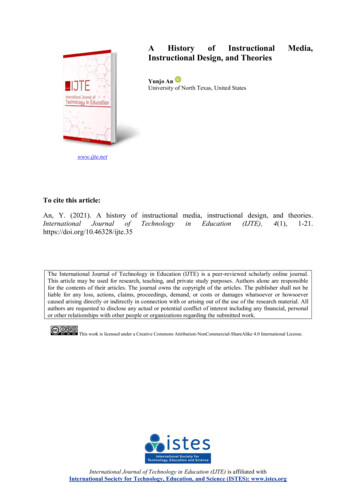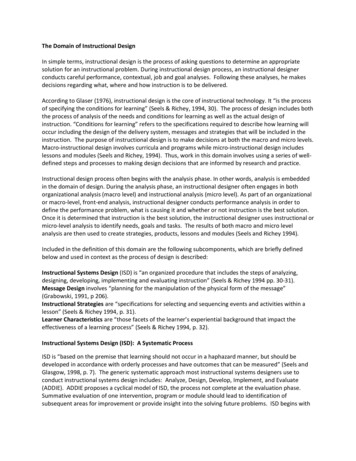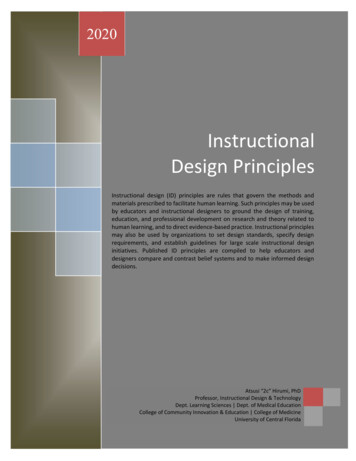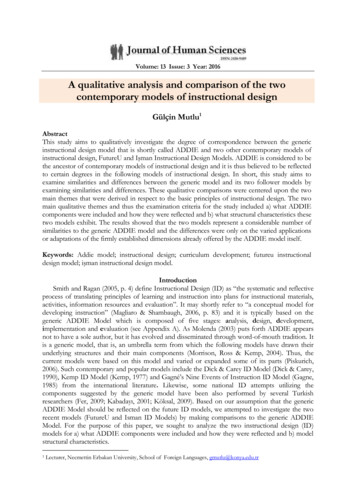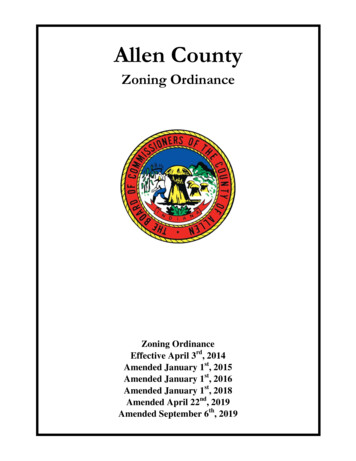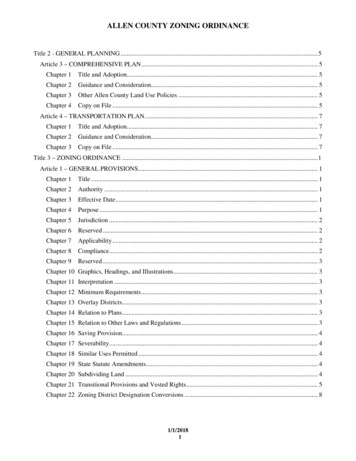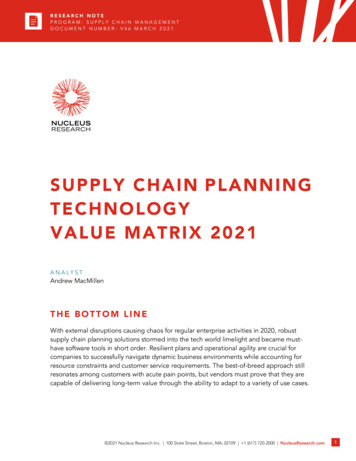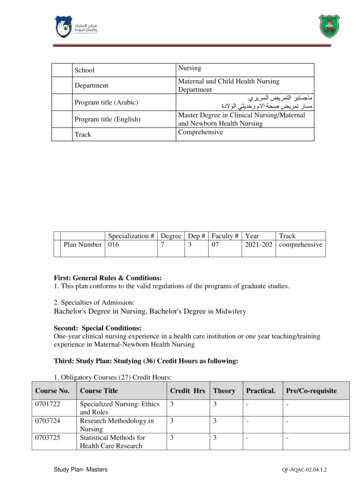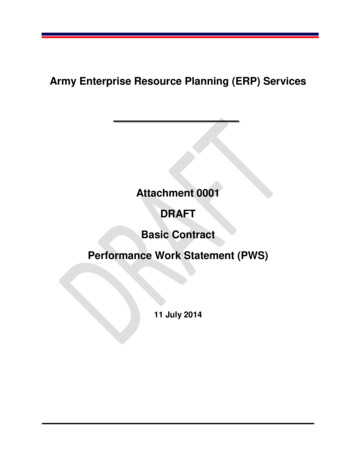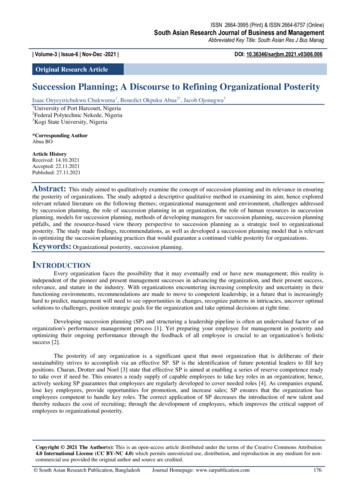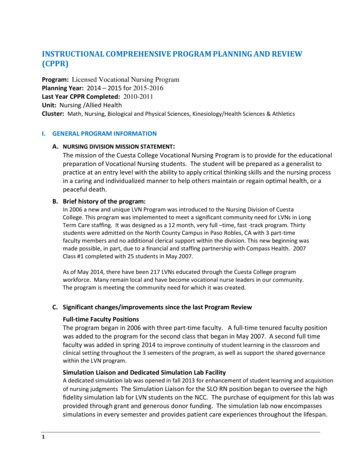
Transcription
INSTRUCTIONAL COMPREHENSIVE PROGRAM PLANNING AND REVIEW(CPPR)Program: Licensed Vocational Nursing ProgramPlanning Year: 2014 – 2015 for 2015-2016Last Year CPPR Completed: 2010-2011Unit: Nursing /Allied HealthCluster: Math, Nursing, Biological and Physical Sciences, Kinesiology/Health Sciences & AthleticsI. GENERAL PROGRAM INFORMATIONA. NURSING DIVISION MISSION STATEMENT:The mission of the Cuesta College Vocational Nursing Program is to provide for the educationalpreparation of Vocational Nursing students. The student will be prepared as a generalist topractice at an entry level with the ability to apply critical thinking skills and the nursing processin a caring and individualized manner to help others maintain or regain optimal health, or apeaceful death.B. Brief history of the program:In 2006 a new and unique LVN Program was introduced to the Nursing Division of CuestaCollege. This program was implemented to meet a significant community need for LVNs in LongTerm Care staffing. It was designed as a 12 month, very full –time, fast -track program. Thirtystudents were admitted on the North County Campus in Paso Robles, CA with 3 part-timefaculty members and no additional clerical support within the division. This new beginning wasmade possible, in part, due to a financial and staffing partnership with Compass Health. 2007Class #1 completed with 25 students in May 2007.As of May 2014, there have been 217 LVNs educated through the Cuesta College programworkforce. Many remain local and have become vocational nurse leaders in our community.The program is meeting the community need for which it was created.C. Significant changes/improvements since the last Program ReviewFull-time Faculty PositionsThe program began in 2006 with three part-time faculty. A full-time tenured faculty positionwas added to the program for the second class that began in May 2007. A second full timefaculty was added in spring 2014 to improve continuity of student learning in the classroom andclinical setting throughout the 3 semesters of the program, as well as support the shared governancewithin the LVN program.Simulation Liaison and Dedicated Simulation Lab FacilityA dedicated simulation lab was opened in fall 2013 for enhancement of student learning and acquisitionof nursing judgments The Simulation Liaison for the SLO RN position began to oversee the highfidelity simulation lab for LVN students on the NCC. The purchase of equipment for this lab wasprovided through grant and generous donor funding. The simulation lab now encompassessimulations in every semester and provides patient care experiences throughout the lifespan.1
Additional Support ServicesA Student Success Specialist was added in 2010. Student retention and 1st time NCLEX passrates success has improved significantly since the onset of this position. A part-time clericalposition began on the North County Campus to support the LVN program where none existedpreviously. This position was initiated, and continues to be fully funded, through a nursinggrant.Curriculum ChangesSkills lab and theory lectures were separated into distinguishable courses, “A” and “AL”.The math prerequisite was increased to pre-algebra level to increase ability and safety withmedication math.A current Nursing Assistant Certification was added as a program pre-requisite to increase timeavailable for actual nursing level skills in the curriculum design.A major curriculum realignment was completed that shifted the program start date fromsummer (May) to fall (August). This change provides LVN students improved access tolearning and support services such as counseling, library, financial aid. It also affords alighter, 10 week, 3rd semester during the summer that is more aligned with facultyassignments college-wide.LVN Licensure PreparationOur 1st time pass rate over the past five years has ranged from a low of 73% in 2011 to a high of96% in 2014. Since 2012, online NCLEX practice tests have been incorporated throughout allsemesters along with a live content review course immediately following graduation to preparestudents for the licensure exam. Kaplan is provided for use by our LVN students at no costmade possible through generous monies from a community foundation partnership.Retention:Retention rate has been over 90% the past four years.The nursing program continues to aggressively implement student success strategies to fosterstudent’s successful completion of the program on time and to prepare students as entry levelclinicians.A pre-program optional preparation for class Workshop was conducted by the AssistantDirector and Success Specialist to identify and address potential academic learning issues andto educate LVN students on successful studying and time management techniques. The goal ofthe workshop is to have students start the program better prepared. Prior to Spring Semester2015, a second optional Workshop in learning Pharmacology was conducted by the AssistantDirector. While this was just conducted a month ago, the initial impression is one also of greatbenefit to students.2
D. List current and/or new faculty, including part-time facultyCurrent Faculty:Ambrose, Mary Ann (FT Faculty, Assistant LVN Program Director)McQuillen, Patricia (FT: new)Johnson, Fay (PT: new)Martinson, Cary Lou (PT: new)Perrin, Shani (PT: new, contracted)Sylva, Sylvia (sub)Sutton, Mel (sub)Pirruccello, Linda (sub)E. Describe how the Program Review was conducted and who was involvedProgram review was constructed from review of ongoing assessment and documentation files forthe LVN program and was put together at the same time as the department’s Total ProgramReview for LVN which has been in discussion phases for some time. The Total ProgramReview allows department staff & faculty to maintain a one stop source for all pertinent LVNmarkers and contains much of the data that is required for the CPPR. The Program Review wasaccomplished through a collaboration of many LVN department staff including the ProgramDirector, Asst Director, Success Specialist and department secretary.II. PROGRAM SUPPORT OF DISTRICT’S MISSION STATEMENT, INSTITUTIONAL GOALS,INSTITUTIONAL OBJECTIVES, AND/OR INSTITUTIONAL LEARNING OUTCOMESA. Identify how your program addresses or helps to achieve the District’s MissionStatement.The Cuesta College LVN Program, in alignment with the school’s mission, vision, andvalues, works to maintain the quality of education our program bya. Maintaining our tradition of providing accessible, high-quality instruction to supportand enhance student success and toenter the health care workforce prepared.b. Seeking advice from our community to assure educational programs address currenthealthcare standards.B. Identify how your program addresses or helps to achieve the District’s InstitutionalGoals and Objectives, and/or operational planning initiatives:Cuesta College Institutional Goals:#1 SLO County Community College District will enhance its programs and services topromote students’ successful completion of transfer requirements, degrees, certificates,and courses.#2 SLO County Community College District will build a sustainable base of enrollment byeffectively responding to the needs of its local service area.#3 SLO County Community College District will assess and improve the quality andeffectiveness of its participatory governance and decision-making structures andprocesses.3
#4 SLO County Community College District will implement, assess, and improve its integratedplanning processes.#5 SLO County Community College District will strengthen its partnerships with localeducational institutions, civic organizations, businesses, and industries.Institutional Goal #1The LVN Program works to promote students’ successful completion of the LVNCertificate by making available numerous student support services to help students besuccessful in class and clinical patient care courses. For example, the program employsa Student Success Specialist who works 18 hours a week dedicated to LVN successhelping manage academic & personal issues with referrals to any number of othercollege resources as required (i.e. personal counseling, financial aid, tutoring, disabledstudent services, etc). The Program also offers Info sessions twice per year for studentsconsidering applying to the LVN Program. The purpose is to elucidate the logistics for ofthe accelerated 12month fast-track program and provides student with a realistic viewof inherent demands mentally, physically, emotionally, and financially so they canprepare accordingly. There is also a mandatory 4 hour orientation held 4 months priorto the start of the program during which student resources are covered in detailaffording ample time for students to utilize prior to program start. This year (2014-2015)first semester we enhanced our services by responding to faculty & student concerns byimplementing a faculty aide for a short time period to help at all 3 clinical sites withinitial student med pass and this proved extremely useful. Other technological advancesincluding the simulation lab have helped with realistic patient care scenario teachings aswell as use of integrated Kaplan NCLEX and Live Review resources to facilitate studentsNCLEX licensure exam success.Institutional Goal #2The LVN Program works to keep the community apprised of application periods andprerequisites through public Info sessions, distributed flyers, website maintenance, andinquiry response (phone and email). The LVN Program maintains close communicationswith Compass Health and other local healthcare facilities through faculty that also workin such institutions outside of classroom or clinical commitments, through graduatesworking in the field, and through facility communication at our twice a year LVN/CANAdvisory Meetings to make sure we are in touch with the LVN demands of our localarea.Institutional Goal #3LVN faculty members participate in college committee assignments, bringing a uniqueperspective of community and student needs to the college.Institutional Goal #4The Integrated Planning Model was presented to full-time faculty at regular facultymeetings. Copies were placed in nursing and allied health break room for reading.4
Institutional Goal #5The LVN Program works to strengthen its partnerships with local education institutions,civic organizations, businesses, and industries by hosting community Advisory Meetingstwice a year with representatives from clinical facilities and local healthcare agencies, aswell as involving LVN staff from Allan Hancock College in Santa Maria, CA. The programalso hosts a completion ceremony for its students at program conclusion where family &friends & local healthcare community have the opportunity to applaud theiraccomplishments. The Program has increased efforts to maintain communication withalumni who are future leaders in the local healthcare industry themselves to growalumni bonding and strengthen the program’s outreach potential for futurepreceptorship, faculty recruiting, and facility association networks. The LVN programhas an Assistant Director on the North County Campus to provide sufficientmanagement resources on the campus on which the program is implemented. TheAssistant Director is integral in these activities.C. Identify how your program helps students achieve Institutional Learning Outcomes.San Luis Obispo County Community College District Institutional Learning OutcomesILO 1. Personal, Academic, and Professional DevelopmentStudents achieving this outcome will be able to:Recognize, assess, and demonstrate the skills and behaviors that promote academicand professional development Recognize, assess, and practice lifestyle choices that promote personal health andmental well-beingDemonstrate the professional skills necessary for successful employmentLVN students are encouraged to lead by example through health and wellness lifestylechoices that promote the program’s Caring Philosophy and Framework. The importanceof taking responsibility for one’s own actions is emphasized. Students are taught theknowledge and application of skills required to demonstrate professional LVN scope ofpractice required for entry level employment in a variety of healthcare settingsthroughout the 3 semesters of the program.ILO 2. Critical Thinking and CommunicationStudents achieving this outcome will be able to: Analyze and evaluate their own thinking processes and those of othersCommunicate and interpret complex information in a clear, ethical, and logicalmannerLVN students are taught to critically think through patient care scenarios in the skills lab,the simulation lab, and challenging patient assignments in clinical. Debriefings take5
place in small, confidential group settings to reflect and strengthen one’s own thinking.In the clinical rotations, students are afforded the opportunity to perform patient caretwo days per week. Patient care expectations progress from simple to complexthroughout the 3 semesters of the program at which time clinical faculty are at hand toassure student preparation prior to performing patient assessment, care, and medadministration. Students are educated on both the ethical and legal elements of HIPAA(Health Insurance Portability & Accountability Act) to ensure all communication remainsconfidential.ILO 3. Scientific and Environmental UnderstandingStudents achieving this outcome will be able to: Draw conclusions based on the scientific method, computations, orexperimental and observational evidenceConstruct and analyze statements in a formal symbolic systemAnalyze the relationship between people's actions and the physical worldMake decisions regarding environmental issues based on scientific evidenceand reasoningLVN students are educated about and must demonstrate the ability to use knowledge ofphysiology, behavioral science, and environmental influence to assess and changes inclients. To perform safe medication administration, students must perform accuratemath calculations and physical assessments of patients. Students must conductmethodical and patient research prior to providing care. Students learn and applyevidence-based research throughout the program to appreciate the concepts of lifelong learning necessary in a healthcare occupation that is ever changing and evolving.ILO 4. Social, Historical, and Global Knowledge and EngagementStudents achieving this outcome will be able to: Analyze, evaluate, and pursue their opportunities and obligations as citizens ina complex worldDemonstrate understanding of world traditions and the interrelationshipbetween diverse groups and culturesLVN students engage in assignments, research, and patient care scenarios incorporatingthe human lifespan spectrum that also entails cultural diversity.ILO 5. Artistic and Cultural Knowledge and EngagementStudents achieving this outcome will be able to: 6Identify, create, or critique key elements of inspirational art formsDemonstrate knowledge of and sensitivity to diverse groups and culturesthrough studying the world's languages, societies, and histories
Many LVN students come from bilingual homes which are an increasing asset inhealthcare whose evolving patient populations increasingly benefits from multilingualpractitioners. Clinical settings and interactions with patients, families, healthcareprofessionals, and faculty provide the opportunity for students to learn key wordshelpful in patient assessment and care in a form other than English. Students arerequired to participate in classroom research projects and presentations also thataddress various cultural sensitivities and understandings. Students learn about thepositive impact art and culture has on wellness and healing. An example: one of the longterm care facilities has a program for residents (including dementia clients) to learn selfexpression through drawing and painting and the students are always amazed at thedepth of personal expression they see in this artwork on the facility walls.ILO 6. Technical and Informational FluencyStudents achieving this outcome will be able to:Recognize when information is needed, and be able to locate and utilize diversesources effectively and ethicallyB. Produce and share electronic documents, images, and projects using modernsoftware and technologyA.LVN students must travel to their assigned clinical rotation facility in advance of theirscheduled clinical shifts in order to perform thorough research on the patients that arescheduled to be under their care so they can be knowledgeable and prepared for thisresponsibility. They are well versed on what information is to be found where from thebeginning of the program and are to honor HIPAA at all times. Students have availableto them both online and textbook resources for their use. This goes for theory(classroom) learning as well. Many clinical facilities the program utilizes have electronicpatient medical record software and computer-based medication administration.Students are provided an orientation to all resources they will be exposed to in a givenclinical rotation in advance of their initiation and faculty maintains communication withfacilities to ensure a thorough orientation at all sites and shifts to other sites throughoutthe program. Students also have various supplemental online resources available tothem through their textbook purchases as well as program supplied Kaplan resources.For classroom and skills lecture portion, faculty present lectures with power point formand made available to students in advance of scheduled lecture for their use andpreparation. Students have the option to print these out for note taking purposes byhand, or may pull-up in class on laptops for typed note taking purposes. Technology isinstrumental in the LVN program in many different ways—simulation mannequinsincluded—and students are technology savvy through support of faculty and staff andcampus resources for that not in possession of their own laptop or home computer.Students are required to perform research and presentation assignments throughoutthe program on various topics and demonstrate not only technology capability but moreoften times than not, significant creativity as well in their sophisticated slideshowformat presentations.7
III. PROGRAM DATA ANALYSIS AND PROGRAMPROGRAM-SPECIFIC MEASUREMENTSA.EnrollmentThe number of enrollments reflects the number of prepre-nursingnursing students enrolled in prerequisitecourses as well as the nursing program. This high number demonstrates the demand andinterest for our program. LVN program enrolls 30 students per year. We continue to have alarge qualified application pool anand turn away over 50 applicants. Forecasting indicates ahigher demand for new graduates by 2015 and beyond with healthcare reform.B.Student Demand (Fill Rate)LVN fill rates for the start of the program are always 100%. The data aboveindicates our fill rates fluctuating from 91.85% to 98.89%. The LVN Program isa 12 month accelerated fastfast-track program comprised of 3 semesters. Theprogram admits 30 students every year but lose students to personal andacademic issues. Varianceariance in fill rate is related to a student drop and theinability to fill the spot due to the inability to make up clinical content.Attrition at the end of each semester (academic or life issues) will decrease fillrates for the next semester.8
C. Efficiency (FTES/FTEF)The data above reveals efficiencyfficiency numbers for both LVN lecture and clinical patient carecourses combined. The clinical patient care courses have a lower student to faculty ratioas mandated by the Board of Licensed Vocational Nursing (BVNPT) which regulates theprogram.The data in the table above shoshows efficiency of the nursing theory courses, without theclinical patient care component, in which one faculty lectures to all students resulting inefficiency that is slightlylightly above the overall college efficiency. The LVNN program admits30 students annuallylly and generates 82 - 85 FTES. We cannot add more mandatedcredits into the three semesters of the nursing program due to BBVNPT regulations.Additional students would be very difficult due to community healthcare (clinical patient9
care) placements as wellll as being responsible to market trends in our community.D. Student Success – Course CompletionThis chart reflects the successful completion (grade C or higher) of all requiredcourses in the three semesters of the LVN program. The LVN Program successrate over the past 5 years has been higher than 95% which averages 25%higher than that of the college overall. This is attributed to the hard work ofour student-orientedoriented faculty and LVN Program Student Success Specialist whowork collaboratively on behalf of our LVN students.Course Completion by ModalityAll LVN classes are face--toto face, there are no online or distance education coursework. Thechallenges to student success are great in this very unique,accelerated fast-trackedfast12 monthprogram.10
E. Degrees and Certificates AwardedThe Licensed Vocational Nursing C.A. certificates awarded represent above a 90%retention rate for the past four years. Every year 30 students are admitted.11
IV. CURRICULUM REVIEWA. All courses that have been created, updated, modified, or eliminated (and approved bythe Curriculum Committee) since the last CPPR are listed below in the Curriculum ReviewGuide and Worksheet.CURRICULUM REVIEW GUIDE and WORKSHEETCourses and ProgramsCurrent Review Date 10 February 2015Reviewer: Mary Ann Ambrose, Marcia Scott, Beth Johnson1. All Courses active in the 3 semester nursing program that have been active since the lastCPPR are listed below. The CurricUNET Course Outline of Record (COR) for each course hasbeen reviewed as indicated yes/no for each column below.Course(Prefix /Number)CurrentlyactiveNew coursesince last CPPRMajormodificationsince last CPPRyes / noMinormodificationsince last CPPRDeactivated sincelast CPPRNotified impactedprogram(s)*yes / noyes / noyes / noyes /LVN 101date:date: 2014date:date:yes / noyes / noyes / noyes / noyes /LVN 101Adate:date:2014date: 2011date:yes / noyes / noyes / noyes / noyes /LVN 101Bdate:date: 2014date:date:yes / noyes / noyes / noyes / noyes /LVN 102date:date: 2014date:date:yes / noyes / noyes / noyes / noyes /LVN 102Adate:date: 2014date: 2011date:yes / noyes / noyes / noyes / noyes /LVN 102Bdate:date: 2014date:date:yes / noyes / noyes / noyes / noyes /LVN 103date:date: 2014date:date:yes / noyes / noyes / noyes / noyes /LVN 103Adate:date: 2014date: 2011date:yes / noyes / noyes / noyes / noyes /LVN 103Bdate:date: 2014date:date:*Note: Please state if the deactivated course impacted any other program(s) and if and whenthe affected program(s) was/were notified:Deactivated CourseLVN103AL12Impacted Program (s)N/AnononononononononoDate affected program was notifiedN/A
2. Course Review - All current active CurricUNET CORs on record have been reviewed by thefaculty for currency and accuracy as annotated below:Course Number1.Effective term listed onCOR2.Catalog / scheduledescription is appropriatePre-/ co-requisites /advisories (if applicable)are appropriate“Approved as DistanceEducation” is accurateGrading Method isaccurateRepeatability is zeroClass Size is accurateObjectives are aligned withmethods of evaluationTopics / scope are alignedwith objectivesAssignments are alignedwith objectivesMethods of evaluation areappropriateTexts, readings, materialsare dated within last 5yearsCSU / IGETC transfer & AAGE information (ifapplicable) is correctDegree / Certificateinformation (if applicable)is correctCourse Student LearningOutcomes are 02LVN103All nursing theoryDate: Fall 2014Spring 2015Summer20151yes / noLVN101ALVN102ALVN103AAll skills theoryDate: Fall 2014Spring 2015Summer20151yes / noLVN101ALLVN102ALSkills labDate: Fall 2014Spring 2015yes / no1Date: Fall 2014Spring 2015Summer20151yes / noyes / no2yes / no2yes / no2yes / no2yes / no4yes / no4yes / no4yes / no4yes / no1yes / no1yes / no1yes / no14yes / no2yes / no1yes / no4yes / no2yes / no1yes / no4yes / no2yes / no1yes / noyes / no1yes / no1yes / no1yes / no1yes / no1yes / no1yes / no1yes / no1yes / no1yes / no1yes / no1yes / no1yes / no3yes / no3yes / no3yes / noyes / no4yes / no4yes / no4yes / no4yes / no4yes / no4yes / no4yes / no4yes / no4yes / no4yes / no4yes / no41yes / no1yes / no2yes / no1yes / no1116. Library materials areyes / noyes / noyes / noadequate and current *1If no, a major modification is needed within the next 5 years (see five-year cycle calendar).2If no, a major modification is needed in the current term. (For increase in class size, see your curriculumrepresentative for details.)3If no, a minor modification is needed in the current term.4If no, contact the Curriculum Chair or Curriculum Specialist.13LVN101BLVN102BLVN103BAll clinical43
3. Programs - All programs/certificates active at the time of the last CPPR are listed below:Program / CertificateTitleNursing, LicensedVocational Nurse C.A. CertificateCurrentlyactiveNew programsince lastCPPRyes / noyes / nodate:Programmodificationsince lastCPPRyes / nodate: 2012 &Deactivatedsince lastCPPRyes / nodate:20144. Program Review- The CurricUNET “Program of Study” outline for each activeprogram/certificate has been reviewed with annotations as indicated below:CurrentlyactiveProgram /Certificate:TitleRequired courses and electives, incl.course numbers, course titles, and coursecredits, are accurateLVN Nursing, LVN 101, 101A, 101B, 101AL, 102, 102A,Licensed102B, 102AL, 103, 103A, 103BVocationalNurse - C.A.Certificate* If not, program modification is needed.** If not, Program Learning Outcomes modification is needed.Programdescription iscurrentProgramLearningOutcomesare accurate andinclude methodof assessmentyes / no*yes / no**B. All curriculums have consistently been reviewed at least annually during Program Reviewmeetings held at the completion of each semester as indicated on the three tables thatfollow. Program Review encompasses student feedback on course surveys, faculty analysisof student learning outcomes, student success indicators of NCLEX pass rates, employmenttracking, and input from Advisory Committees and community healthcare agencies. Ourphilosophy and curriculum has continued to be timely and relevant in today’s healthcaresetting.The LVN program completed a major review and curriculum changes in 2013 that approvedby the Board of Vocational Nursing (BVNPT) and the college curriculum process. Thesechanges were implemented in Fall 2014.The LVN program has just completed its regular continued program approval with theBVNPT in fall 2014. The next major review will be with the next program reapproval inApril 2019 with the BVNPT. Through this process, all courses were evaluated by faculty inpreparation for this review, and the courses met regulatory scrutiny, that the followingCOR’s were current and accurate for the following in CurricUNET:14
Course descriptionStudent learning outcomesPre-requisites/co-requisitesTopics and scopeCourse objectivesAlignment of topics and scopes, methods of evaluation, and assignments withobjectivesAlignment of SLOs and objectives with approved requirement rubrics (GeneralEducation, Diversity, Health, Liberal Arts)TextbooksCSU/IGETC transfer and AA GE informationDegree and Certificate informationV. PROGRAM OUTCOMES, ASSESSMENT AND IMPROVEMENTSA. The assessment cycle calendar for the LVN program may be referenced in Section VII:END NOTES.B. Course and Program Assessment Summary (CPAS) forms may be referenced inSECTION VII: END NOTESC. Mapping of course-level SLOs connect to program-level SLOs is imbedded in theProgram CPAS document above.D. Improvement efforts that have resulted from SLO and program assessment include: Created more simulation activities.Added a 4th patient bay in skills lab.Purchased additional specialized wound models for skills lab.Purchased CPS clicker tools for engagement in classroom and NCLEX style learning.Reintroduced the LVN104 IV/Phlebotomy Certification Course for post-completion alumni.Placed on prioritization list: updated DVDs for skills demonstration and nursing theory.Donations obtained to create a dedicated simulation lab on NCC.E. Recommend changes and updates to program funding based on assessment of SLOs.Refer to Unit Plan Funding Request Worksheet.F. Budget requests that are related to student learning outcomes assessment results orinstitutional/programmatic objectives include: 15Professional development to be provided for faculty to remain current in healthcaretrends and nursing content.Larger skills lab to accomodate a five (5) patient bay to meet BVNPT required standards for30 students (6 students per patient unit/bay).Simulation Lab expansion to include multiple patients to increase scenarios on timemanagement and prioritization skills.Fund Simulation Liaison to oversee the NCC simulation lab which has been integrated intoall three semesters and encompasses lifespan and diversity issues.Updated and/or new equipment for lecture demonstration and student practice.
Purchase an electronic healthcare record program for students through all semesters of theprogram as this will be instituted in all healthcare facilities students will rotate to for patientcare clinicals.Continue to review skills kit content for currency, necessity and cost of supplies. It isimportant to have students purchase a kit (materials fee) that is usable and supports thecourse objectives.Continued purchase of National Council of State Boards of Nursing (NCSBN) Program Reportdata.Update content specific instructional media as indicated throughout SLOs.VI. PROGRAM DEVELOPMENT/FORECASTINGThe following is a brief description of the nursing program’s forecasting elements and supportefforts to continue to meet course and program outcomes:Levels or delivery of support servicesNew support servic
The LVN Program works to promote students' successful completion of the LVN Certificate by making available numerous student support services to help students be successful in class and clinical patient care courses. For example, the program employs a Student Success Specialist who works 18 hours a week dedicated to LVN success
